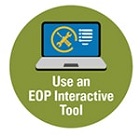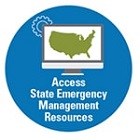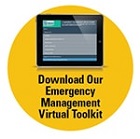|

Plan Ahead and Be Prepared for Spring Weather
Seasonal changes from winter to spring come with an increase in the likelihood of occurrence for certain natural hazards. Spring natural hazards such as floods, tornadoes, thunderstorms and lightning, tsunamis, and extreme heat can cause damage to buildings and grounds, disrupt emergency and medical services, and even result in injury or death. Develop or revise your emergency operations plan (EOP), conduct exercises and training, and share information with your whole school or campus community so that your school, school district, and institution of higher education (IHE) can plan ahead and be prepared for spring natural hazards before they occur.
Engage in Spring Safety
There are multiple stakeholder events this season that can support your efforts to share preparedness information with your whole school or campus community, plan for spring natural hazards, and be weather-ready no matter the forecast. Tuesday,
March 1, 2022,
marked the beginning of the
Spring Safety Campaign, a seasonal awareness initiative led by the National Weather Service (NWS) that aims to build a
Weather-Ready Nation.
The 2022 theme is “Helping Others,” especially those most vulnerable, which includes children and individuals with disabilities and access and functional needs. NWS offers
social media plans,
infographics,
videos,
presentations, and
Spanish content
that you may use to participate. Remember to follow the hashtag
#WeatherReady
and to use it on your social media posts to raise awareness and draw on the resources, trainings, and other materials being shared as a part of this activity.
#SafePlaceSelfie
day is
Wednesday, April 6, 2022.
This event provides a fun, creative, and interactive opportunity for your education agency and community to think about shelter-in-place plans before an emergency occurs and identify safe locations. Mark your calendars and brainstorm ways your school, school district, or IHE can participate. For example, engage in scenario-based planning to think about the various ways a hazard could unfold and review your
Shelter-in-Place Annex.
If your school/campus has safe rooms, your planning team may use this event as an opportunity to conduct a walk-through and check emergency supplies. Consider reviewing other annexes that may be activated in your EOP, such as the
Evacuation Annex.
Planning teams can use this event as an opportunity to collaborate with first responders to determine evacuation routes and rally points to safe locations, train students and staff on evacuation procedures, and/or share information specific to individuals with access and functional needs and in multiple languages. Once this event has passed, consider having your education agency showcase your participation on social media to continue raising awareness about spring natural hazards and your EOP.
Access Resources
The REMS TA Center’s
Topic-Specific Resources Section
offers resources that can help you prepare for spring
natural hazards
and
shelter-in-place. Featured on these pages are Preparing for Floods Fact Sheets – tailored for
K-12 Schools and School Districts,
State Education Agencies,
and
Institutions of Higher Education
– and an accompanying
flooding resource list, a
Sample Shelter-in-Place Annex,
and other resources from Federal partners.
Additionally, the
REMS TA Center Tool Box
contains resources from state and local partners on spring natural hazards, including a
tabletop exercise
for tornadoes from the Missouri Center for Safe Schools;
procedures
for tsunamis from Lincoln County School District in Oregon; and a
case study report
on flooding from the California Governor’s Office of Emergency Services, California Department of Education, CalRecycle, and Sacramento County Office of Education. If your education agency has created tools, documents, templates, or presentations for spring natural hazards, shelter-in-place, or another emergency management planning topic, please complete the
Tool Box Submission Form.
|










